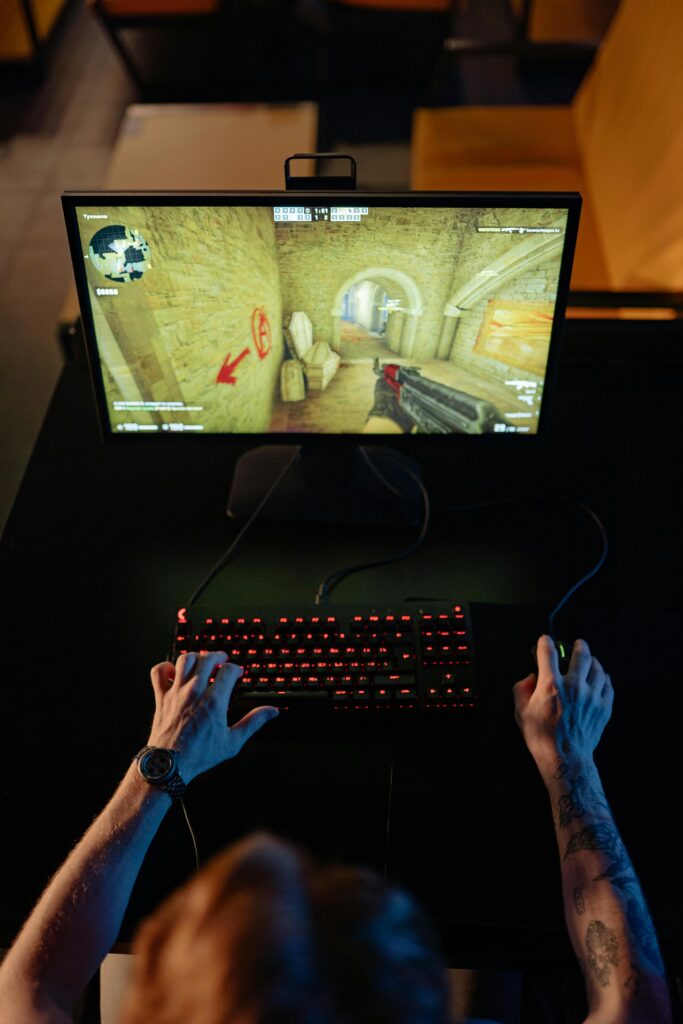Game Based Learning: Re-Energizing the Study of History with Video Games
Samantha Matalone Cook, MAT
Game Based Learning in the Classroom and Beyond
It’s no secret that our family is a gaming family. Board games, video games, role-playing games, you name it, we play it. In many of the workshops I have given over the years, I’ve pointed out that using game based learning can be a wonderful catalyst to academic subjects. I’ve used games to introduce, connect, or reinforce concepts. Previously, I’ve used games as a strewing technique to gauge interest in an idea. Often, I’ve used games to branch out into new knowledge and skills. I’ve even made games with my students.
In this article, though, I want to focus on video games. Video games are often the least understood and utilized option in education, but have extremely high engagement and many benefits. If you are looking to re-energize your study of history, you may want to consider playing some video games!
Benefits of Video Games for Learning
Video games have a lot going for them, such as enhancing hand-eye coordination, strategic and creative thinking, and social cooperation. The awesome benefits of playing video games could be a full article on its own. But if we focus on history and the catalyst that video games can provide between a student and this subject, some very specific opportunities come to light.
There’s a story I have told in a few workshops and keynotes about my favorite example of a video game sparking an interest in history. It involves my middle child, as he was entering adolescence. To be frank, not much seemed to be of interest to him at all, much less history. He was deep into his cocooning, a phase in which many teens withdraw as they cope with this developmental transition. Gaming, however, was one of the few things that remained consistent and a source of connection. So, we played games. Lots of games. One of those games was a video game called Assassin’s Creed.
Assassin’s Creed is an open-world action-adventure stealth video game. In an open-world game, players freely explore a virtual world and pursue objectives without strict, pre-determined pathways or required actions. The game features a combination of historical fiction, science fiction, and real historical events and figures. There are about 24 games in the Assassin’s Creed franchise, and while the storyline varies for each of them, there is a consistent thread throughout them all: a long-term struggle for peace between the Assassins and the Templars. Each of the games is set in a different historical time period, and this is where my son and I first found common ground.

Approaches to Game Based Learning: Passive and Active Methods
There are two different approaches I take with games of any kind when connecting them to a subject: passive and active.
Passive: Letting the student get what they need out of the game, and letting the game teach in the way it is designed.
I often start this way because it gives me helpful information without turning the video game into a lesson right away, which can discourage many kids. If I am strewing the game to find out if the subject matter is an interest of my student, I might stop there if no interest is shown. If it is a subject I am going to be covering regardless, the game often serves as my opening hook to draw them in and start a conversation. I then take an active approach to the game.
Active: Surveying the history presented for accuracy, studying historical figures, events, or groups individually, analyzing the plot and virtual world created in the game, and looking for other subjects that are deeply tied to the history in the game.
Note that even while actively approaching the game, the game is still passively teaching. An example can be seen as follows.
Case Study: Learning History Through Assassin's Creed III
The first version of Assassin’s Creed my son and I played together was Assassin’s Creed III, set around the American Revolution. At first, we simply played the game and had conversations about strategy, the characters, the setting, etc.
This passive approach allowed us to get a sense of gameplay and become comfortable with the setting. My son soon became interested in several elements in the game. He liked the visual style of the main character, so he learned about cosplay, learning to sew and make the props. I began pointing out what was accurate and what wasn’t about the American Revolution, which turned into a longer-term study of people and events of the 18th century.
I want to point out that doing this even just once gave him the tools to examine other time periods: knowing what to look for, what questions to ask, and how to research. It set a foundation that he has built on with each subsequent game he plays and historical period he studies.
The spectacular visual world created in the game also got him interested in art and architecture, which he has studied both historically and as a drawing form. Finally, this (and many other games) sparked a continuing interest in game design and development. He’s taken several classes on the subject as a result.
In all, this experience left us wanting more and we have since used many other games as a bridge to exploring academic subjects. Every time there are similarities in the way we study the history and differences that are specific to the game.
As he has gotten older and defined some long-term academic goals for himself, we have expanded our use of writing and projects about games in a more formal way. I’m in my last year of homeschooling this teen and he happens to enjoy Norse mythology and history which coincides with the release of the latest Assassin’s Creed game: Valhalla, so I recently rearranged our plans so we could immerse ourselves one more time.
This is just one of many games and game franchises I’ve used over the years with both my own kids and students from my classes. There are many options for every level of age and ability, and every gaming platform available.
While I have focused in this article on games that already employ a historical setting, don’t forget that even non-historical games can be used to tie in the history of an interest. For example, I once helped a student create a “History of Batman and Robin” project (that included a history of superhero gadget design!) based on their love of the Lego Batman video game.


Practical Tips for Integrating Video Games into Education
Again, you can use game based learning through video games in a myriad of ways to explore academic subjects. Here are some simple reminders:
- Use the game as a hook to introduce a time period, either for study or to observe interest.
- Invest in learning about the time period and make a list or chart of what is historically accurate and what is not.
- If the storyline appeals to your learner, find out if any franchise books or fan fiction has been written to accompany the game. If not, or in addition, find appropriate historical non-fiction or fiction to add to your study of history.
- Try drawing and painting in the style of the game, or use an online program to develop their own game, if the art and visual game design attracts your learner. They can also study the art history of the time period to find influences on the game.
- Speaking of their own game, learners may want to do a project in which they re-imagine the game they are playing or be challenged to change it so that it is historically accurate. They could also design an entirely new game according to how they would have created it.
- Cosplay, map-making, prop-building, figurine painting, and other forms of making and craft are legitimate, kinesthetic ways to connect learners to the story, and therefore the history.
- If your learner is not interested in history, find something else about the game that appeals to them first. Maybe it’s strategy, or building, or the characters. Whatever it is, start there and work up to exploring the history.
- You can also begin with the games they are already interested in. Perhaps it’s a certain genre of games or it’s a game that all their friends are playing, but you can find a bit of history in any game and build up their interest before introducing games that are more history centered.
- Some games are about a general time period and some are about a specific event or person. Choosing games based on what they cover can be strategic and useful.
- Some games have educational options to enhance your study of history. For example, Assassin’s Creed has both a Story Creator Mode, which allows you to create your own narratives in the game, and Discovery Mode, which allows you to explore the virtual world they have created without gameplay. Another example is Minecraft, which has an education program, but also has historical mods you can download and add to your regular gameplay.
- Many of the video games based on history involve conflict and war, though there are a some that do not. Some video games have educational components that let you bypass battles. Regardless of which games you choose to explore, I recommend having discussions with your learner around the themes found in video games, which is another bridge to understanding history.
- If you have a VR gaming system, there are some terrific new options continuing to develop that offer an immersive experience of historical settings and storylines!
- While you don’t necessarily need to play the video games yourself, you should at least spend some time watching your student play and talking about the game. It can also bring a wonderful new dimension to your relationship with your child. Investing the time to learn about and embrace your child’s passions is an expression of love, support, and understanding. In my experience, what follows is an openness to possibilities for both parent and child.

Recommended Video Games for Game Based Learning
Below are some other favorite video games to explore history. This is by no means a complete list, and neither is this list on Wikipedia, but it is meant to get you started thinking about how you can incorporate video games into your student’s study of history. I’ve given a general age range, but every learner is different in ability and sensitivity, and every family has their own boundaries on elements such as strong language, violence, and sexual themes. If you are unsure about a game, I suggest you read reviews, such as those on Common Sense Media and have an open dialogue with your student about what games they would like to play and how you will approach more mature themes.
Minecraft and Minecraft Education (all ages)
One of the most popular games in the world, Minecraft has a few options. There are mods that have historical elements to them that you can download and add to your gameplay. You can also get lesson plans from Minecraft Education that are specifically designed to teach history. Minecraft also has the benefit of having multiple players in the same world, making collaboration possible.
Spore (all ages)
I included this game because I’ve used it several times to teach evolution in a prehistory unit. Kids love determining the fate of their creatures through the five stages of evolution: cell, creature, tribe, civilization, and space. Spore is a terrific way to connect science and history.
When Rivers Were Trails and Never Alone (all ages)
When Rivers Were Trails is a game similar to Oregon Trail, in which a member of the Anishinaabeg is displaced from their traditional lands in Minnesota during the late 19th century and heads west to California. Never Alone (Kisima Ingitchuna) is the journey of an Iñupiat girl (Alaska Native) and an arctic fox as they encounter obstacles while trying to save the girl’s village. Both games were created by and/or in collaboration with Indigenous contributors.
Civilization (middle school and up)
Sid Meier’s Civilization has captivated players for years and remains one of the best strategic historical games. The basic concept is that you attempting to build an empire that will last. Beyond the foundation game, there are also expansions you can purchase for extended and more complex play.
Hearts of Iron (middle school and up)
There are several versions of this, but my son’s favorite is Hearts of Iron IV, which and allows you to take command of any country in World War II. This game is high in strategy and critical thinking and explores the idea of alternate history.
Banner Saga (middle school and up)
Banner Saga is a Nordic role-playing game trilogy; the story builds based on your choices actions as you try to save your people.
Imperator Rome (middle school and up)
In this game, students immerse themselves in building the Roman Empire, exploring culture, politics, geography, deities, and conquests.
Ancestors: The Humankind Odyssey (middle school and up)
For students who want a more intense experience of guiding human evolution, Ancestors: The Humankind Odyssey allows players to evolve their clan to the next generation, building on adaptations and mutations for survival.
Europa Universalis IV (high school and up)
Another empire building game that uses strategy and creativity. Europa Universalis IV has multiple expansions available, set in different parts of the world.
Total War (high school and up)
The Total War sagas focus on a specific time period or region, while players immerse themselves in the story through strategy, diplomacy, and action.
Assassin’s Creed (high school and up, possibly middle school and up)
Depending on your comfort level, this game could be played by students in middle school, but it is rated M (for Mature, 17+). The older games are less realistic than the more recent versions, and each version takes place in a different time period and part of the world. Assassin’s Creed also has, as mentioned above, both a Story Creator Mode, which allows you to create your own narratives in the game, and Discovery Mode, which allows you to explore the virtual world they have created without gameplay. The Discovery Mode has no battle or quests, just the environment.

Game Based Learning: Re-Energize Your Studies
Meet the Author!
Video games can be an awesome way to connect learners to a myriad of subjects and re-energize your studies. While video games may not be the conventional choice in studying history, it is a fun, engaging, and multidimensional way of studying the past that will delight many learners. They may ignite, or re-ignite, an interest in history for your student!

Meet the Author!
Samantha Matalone Cook, MAT, is an educator, historian, writer, maker, and speaker. She has almost three decades of experience in education and program development, and has worked with both small and large organizations to create educational programming that centers and connects the learner to concepts and skills. Her experience includes teaching in classrooms and in private workshops, mentoring other educators, and working for and with many museums including the Smithsonian. She also finds new adventures and manages mischief every day with her two teens and one preteen, all home educated; the oldest of whom has fledged to college. Currently, her favorite games are The Quiet Year, Talisman, Code Names, Azul, Minecraft, Assassin’s Creed: Valhalla, The Legend of Zelda: Breath of the Wild, Moss, and Beat Saber.
To see her past and current projects, including her blog, her book on Project-Based Learning, her Harry Potter-themed book studies, Pandia Press History Odyssey curriculum, and her course offerings through SEA Online Classes, please visit www.samanthamatalonecook.com





